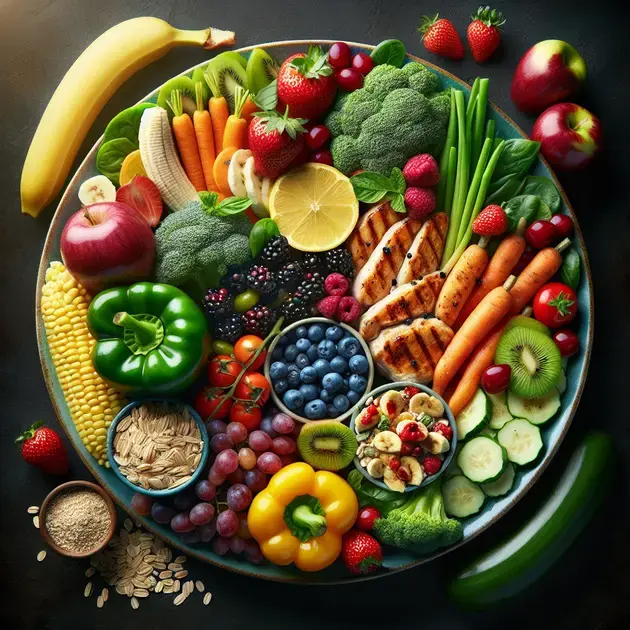Maintaining healthy eating habits is crucial for overall well-being and longevity. In today’s fast-paced world, where convenience often trumps nutrition, it can be challenging to make the right choices. However, with the right knowledge and strategies, achieving a balanced diet is more achievable than ever.
One key aspect of healthy eating habits is ensuring that your meals are rich in nutrients and low in processed foods and added sugars. By focusing on whole foods such as fruits, vegetables, whole grains, and lean proteins, you can fuel your body with the essential vitamins and minerals it needs to function optimally. Making small but sustainable changes to your diet can have a significant impact on your health in the long run.

Developing a Sustainable Meal Plan
Developing a sustainable meal plan is essential for long-term health and well-being. One approach is to start by assessing your current eating habits and identifying areas for improvement. A helpful tool for this is the MyFitnessPal app, which allows you to track your daily food intake and analyze your nutrient consumption. By understanding your eating patterns, you can then begin to make small, sustainable changes.
Next, consider incorporating a variety of nutrient-dense foods into your meal plan. Websites like EatThisMuch can generate meal plans based on your dietary preferences and calorie goals, ensuring you get a balance of essential nutrients. Include plenty of fruits, vegetables, whole grains, lean proteins, and healthy fats in your meals to support overall health.
Meal prepping is another key aspect of a sustainable meal plan. Apps like Mealime can help you plan and prepare your meals in advance, saving time and reducing the temptation to opt for unhealthy convenience foods. Dedicate some time each week to batch cooking, portioning out meals, and storing them for easy grab-and-go options.
Don’t forget about sustainability when planning your meals. Consider choosing locally sourced, seasonal ingredients to reduce your carbon footprint and support local farmers. Apps like Farmdrop can connect you with sustainable food producers in your area, making it easier to make environmentally conscious choices.
Finally, stay flexible and make adjustments as needed. Your meal plan should be a guide, not a strict set of rules. Listen to your body, make note of what foods make you feel your best, and be open to trying new recipes and ingredients to keep your meals exciting and enjoyable.
Incorporating Nutrient-Dense Foods
Incorporating nutrient-dense foods into your diet is a great way to improve your overall health and well-being. Start by familiarizing yourself with nutrient-dense options such as leafy greens, berries, nuts, seeds, and lean proteins. Websites like ChooseMyPlate.gov offer detailed information on recommended food groups and portion sizes.
One strategy for incorporating more nutrient-dense foods is to gradually swap out less healthy options for nutrient-rich alternatives. For example, replace sugary snacks with fresh fruit, and opt for whole grains instead of refined grains. The Fooducate app can help you scan product barcodes and choose healthier options while grocery shopping.
Building balanced meals is key to incorporating nutrient-dense foods. Aim to include a source of protein, healthy fat, and fiber in each meal to keep you satisfied and nourished. Apps like Yummly offer personalized recipe recommendations based on your dietary preferences and can help you discover new ways to incorporate nutrient-dense foods into your meals.
Experiment with different cooking methods to enhance the nutrient content of your foods. Steaming, roasting, and sautéing vegetables can help preserve their vitamins and minerals. The Forks Over Knives app provides plant-based recipes and cooking tips to help you make the most of nutrient-dense ingredients in your meals.
Don’t forget to stay hydrated and listen to your body’s hunger and fullness cues. Incorporating nutrient-dense foods is not just about what you eat, but also how you nourish your body with hydration and mindful eating practices.
Making Small, Sustainable Changes
Making small, sustainable changes to your eating habits can have a long-lasting impact on your health and well-being. One approach is to start by setting realistic and achievable goals. The Habit app allows you to track your habits and set reminders to help you stay on track with your dietary changes.
Focus on one change at a time to avoid feeling overwhelmed. For example, you could start by incorporating an extra serving of vegetables into your meals each day or swapping sugary beverages for water. Apps like Habitica gamify habit-building and can make the process of making small changes more engaging and rewarding.
Gradually reducing your intake of processed foods and added sugars can also lead to significant improvements in your overall health. Use apps like MyPlate to track your daily sugar intake and identify sources of hidden sugars in your diet. Making swaps like choosing plain yogurt over flavored yogurt can help reduce your sugar consumption.
Supportive communities and resources can also be valuable when making small changes to your diet. Joining online forums or social media groups focused on healthy eating can provide encouragement, accountability, and recipe ideas. The Reddit community r/EatCheapAndHealthy is a great place to find budget-friendly and nutritious meal inspiration.
Celebrate your progress and be kind to yourself throughout the process of making small, sustainable changes. Remember that every positive choice you make, no matter how small, contributes to your overall health and well-being in the long run. Stay consistent, stay patient, and most importantly, enjoy the journey to a healthier you.

Developing a Balanced Exercise Routine
Developing a balanced exercise routine is crucial for overall health and well-being. It involves a combination of cardiovascular exercise, strength training, flexibility work, and rest days. To create an effective routine, follow these steps:
Step 1: Set Specific Goals
Start by identifying your fitness goals, whether it’s improving endurance, building muscle, or losing weight. Having specific goals will help you tailor your exercise routine to meet your needs.
Step 2: Choose a Variety of Exercises
Include a mix of cardio, strength training, and flexibility exercises in your routine. This will help you target different muscle groups and prevent boredom.
Step 3: Create a Schedule
Determine how many days a week you can dedicate to exercise and create a schedule that includes different types of workouts. Be sure to also incorporate rest days to allow your body to recover.
Step 4: Track Your Progress
Keep track of your workouts and progress towards your goals. This can help you stay motivated and make adjustments to your routine as needed.
Step 5: Listen to Your Body
Above all, listen to your body. If you’re feeling fatigued or experiencing pain, it’s important to rest and recover to prevent injury.
Exploring Mindful Eating Practices
Exploring mindful eating practices can help improve your relationship with food and promote better digestion. Mindful eating involves being present and aware of your food choices and eating habits. Here’s how to incorporate mindful eating into your routine:
Step 1: Eat Without Distractions
Avoid eating in front of the TV or computer. Instead, focus on the taste, texture, and aroma of your food to fully enjoy the eating experience.
Step 2: Chew Slowly
Take your time to chew each bite thoroughly. This not only aids digestion but also allows you to savor the flavors of your meal.
Step 3: Pay Attention to Hunger Cues
Listen to your body’s hunger and fullness signals. Eat when you’re hungry and stop when you’re comfortably satisfied.
Step 4: Practice Gratitude
Before eating, take a moment to express gratitude for the food in front of you. This can help cultivate a positive relationship with food.
Step 5: Be Mindful of Portion Sizes
Avoid eating out of large containers or packages. Instead, portion out your food onto a plate to help control serving sizes.
Understanding Macronutrients and Micronutrients
Understanding macronutrients and micronutrients is essential for maintaining a healthy and balanced diet. Macronutrients, including carbohydrates, proteins, and fats, provide energy and are needed in larger quantities. Micronutrients, such as vitamins and minerals, are required in smaller amounts but play important roles in overall health. Here’s a breakdown of each:
Macronutrients
Carbohydrates are the body’s main source of energy and can be found in foods like grains, fruits, and vegetables. Proteins are essential for building and repairing tissues and can be found in sources like meat, fish, and legumes. Fats are important for hormone production and cell function and are found in foods like nuts, seeds, and oils.
Micronutrients
Vitamins and minerals are crucial for various bodily functions, including immune support, bone health, and energy metabolism. Sources of micronutrients include fruits, vegetables, dairy products, and whole grains.
By understanding the role of macronutrients and micronutrients in your diet, you can make informed food choices to support your overall health and well-being.
Conclusion
In conclusion, developing a balanced exercise routine is essential for maintaining overall health and well-being. By incorporating cardiovascular exercise, strength training, flexibility work, and rest days into your routine, you can target different muscle groups and prevent workout monotony. Setting specific fitness goals, choosing a variety of exercises, creating a schedule, tracking your progress, and listening to your body are key steps in creating an effective exercise regimen.
Mindful eating practices are equally important in fostering a healthy relationship with food and enhancing digestion. By eating without distractions, chewing slowly, paying attention to hunger cues, practicing gratitude, and being mindful of portion sizes, you can improve your eating habits and savor the flavors of each meal. These mindful eating habits can lead to a more positive connection with food and promote better overall well-being.
Understanding the significance of macronutrients and micronutrients is crucial for a balanced diet. Carbohydrates, proteins, and fats are essential macronutrients that provide energy and support various bodily functions. On the other hand, vitamins and minerals, the micronutrients, play vital roles in immune support, bone health, and energy metabolism. By incorporating a variety of foods rich in macronutrients and micronutrients, you can make informed dietary choices to support your health and well-being.